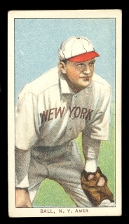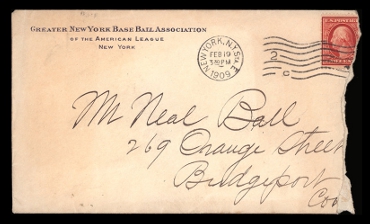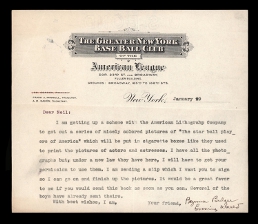One of the more important items relating to the T206 set is known as the Neal Ball letter. This letter, along with a newspaper account of Honus Wagner receiving a similar letter, provides a great deal of insight into how the players came to be included in the set.
The Neal Ball letter was typed on a single piece of The Greater New York Base Ball Club stationary and dated Jan. 29, 1909. It was written by Evening World writer Bozerman Bulger and addressed to Neal Ball, a player for the New York Highlanders. The letter's stated intent was to get the written permission from Ball to use his picture for a set of lithographed baseball cards to be inserted into cigarette boxes. Bulger included with the letter a slip of paper to be signed and returned by Ball as proof of permission to use his likeness.
According to an article from Oct. 24, 1912, Honus Wagner was sent a similar letter by a local newspaper writer. Ralph Davis recounts the following in the Sporting News article:
"Not to (sic) long ago a firm of tobacco manufacturers wrote to a local newspaper man and asked him to secure a picture of Hans Wagner to be given away with cigaretes (sic) together with the written permission of the big Dutchman to use it. The writer was promised a liberal fee for his work in landing the photo.
"The scribe wrote to Wagner and asked him for the picture enclosing the tobacco company's letter. A few days later he received a communication from Hans saying that he did not care to have his picture in a package of cigaretes (sic) neither did he wish his friend to lose the chance to cop a little extra coin. 'So,' he concluded, 'I enclose my check for the amount promised you by the tobacco company in case you got my picture and hope you will excuse me if I refuse.' "
A few things are interesting to note. First, Bulger says he is writing on behalf of the American Lithographic Company, and in the Sporting News article the writer is said to be contacting Wagner on behalf of a tobacco company. Second, Bulger tells Ball that he already has his photograph and only needs his permission to proceed, but according to the article, Wagner was asked to provide a photo and his written permission.
Both the Ball letter and Wagner story are examples of how ATC and ACL paid local writers to contact players in an effort to receive written permission to include them in the set.




